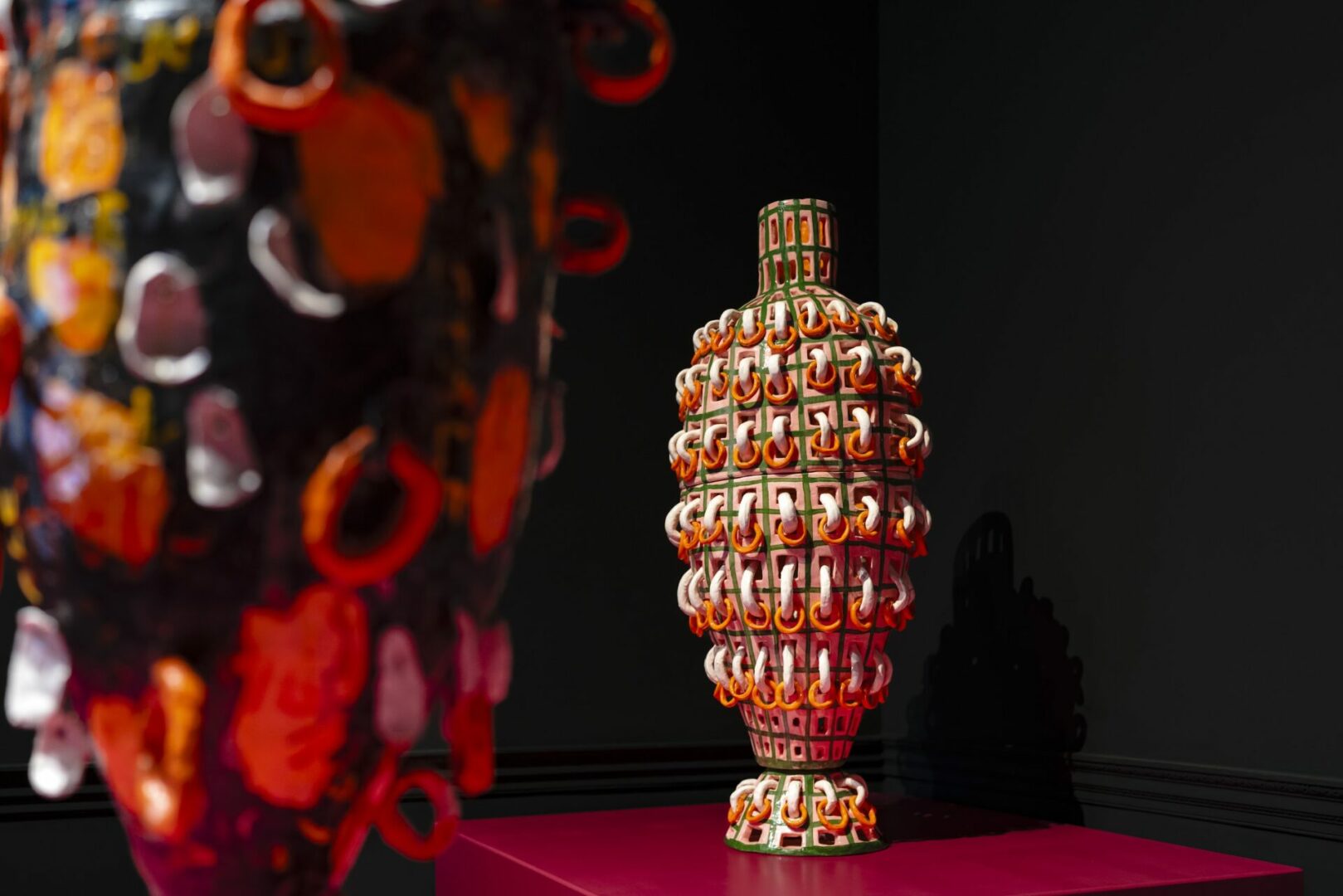To be endangered, a species must meet certain criteria. Between 50% and 70% of their population must have decreased within a decade, their population must be less than 2,500 adults or there must be a statistical prediction they will go extinct within the next 20 years. But these criteria can be applied to more than animals and plants – in 2017 the Heritage Crafts Red List of Endangered Crafts was published. It showed that 150 crafts in the UK are at risk of becoming extinct, and some have already ceased to be practiced in the country – including cricket ball making, gold beating and lacrosse stick making. Now, Harewood House’s 2024 Biennial Create/Elevate foregrounds the artists and collectives using craft for cross-generational knowledge sharing. The contemporary exhibition provides new ways of engaging with centuries of craft artistry and reminds us of the importance of keeping these skills alive for the next generation. Darren Pih is Chief Curator and Artistic Director at Harewood House. He is dedicated to art and creative ideas that engage with urgent issues of decoloniality, environmental responsibility, inclusion and new social histories. Ligaya Salazar is a curator focused on the intersection of design, art and craft, seeking to place people at the heart of storytelling. We spoke to them about how the process of curating the Biennial, why craft is so important and how the exhibition intersects with Harewood House’s history.
A: The Harewood Biennial 2024 celebrates the power of craft knowledge. Why did you decide to theme it around this idea? Why are crafts important?
DP: We wanted to curate an ambitious exhibition that embraced the voices of artists and collectives, as well as makers. Create/Elevate explores craft as a skilful expression that can be useful, beautiful and critical of our current times while providing models for living and learning. There’s an inherent democracy within it. Beyond simply looking at and admiring craft, it can be active, accessible and participatory. We might touch, listen to and sometimes even taste it. Collaboration and cross-generational knowledge sharing are the foundation of most things we know, use and value. We also wanted to embrace the work of makers from the Global South, to expand and complicate the narratives of English country houses.

A: You say that crafts “illuminate our current times while providing models for living, learning and thriving together”. Could you tell us a bit more about this?
LS: We noticed a tendency for artists working with artisan communities to often self-organise and work to affect societal change and promote equity. Often, their work addresses neo-colonial exploitation of land where capitalist processes have disrupted communities. By working with materials in a non-extractive manner, learning about practices like this encourages concern for nature and food security.
A: Create/Elevate showcases the work of 16 international contemporary artists, from Mani Kambo’s hand block wallpaper, to the sculptures of Lucia Pizzani. What was the process like of determining who will feature in the Biennial? What is it about these artists that stands out to you?
LS: We were really keen to expand the idea of what kind of creative practitioners work with craft. In recent years, a resurgence of contemporary artists working with practices galvanised our intention to include these in the third Harewood Biennial, which had previously primarily included designers and makers. One of the key messages of the Biennial was that craft has the power to bring people together to imagine new worlds. We were also intent on including people with a focus on collective making, which is why Create/Elevate features several collaborations which happened across different continents. Last, but not least, we felt it was important to address Harewood’s complicated history through several of the commissions. We were keen for the selection of existing, new and commissioned works to enable new perspectives on Harewood. Each one of the selected artists, designers, makers and collectives does so in a specific way by responding to the surrounding they are placed, whether that is the house or the gardens.

A: Harewood Biennial centres around three interwoven themes: New Narratives highlights works the integrate Harewood’s history, The Use of Land foregrounds local and global ecologies and Nourish explores the effects of sharing food and knowledge. Could you explain how you decided to shape the exhibition around these ideas?
LS: We wished for the Biennial to feel connected and rooted to the experience of Harewood House, the gardens and land that surround it rather than a series of interventions. So these interconnected themes were a result of the types of work we were interested in including in the Biennial and their relationship to the complex histories, geographies and economies of Harewood as a place. For example, the commissioned work by Venezuelan artist Lucia Pizzani is presented in the Walled Garden and explores the Mesoamerican ‘three sisters’ technique of companion planting. It’s a beautiful work and was created by the artist in collaboration with Trevor Nicholson, Harewood House’s Head Gardener.
A: The Biennial honours the traditions and history of Harewood House and the surrounding area, whilst also considering global ideas of heritage and generational knowledge. How did you strike that balance when putting together the exhibition? Why was it important to have both perspectives?
LS: We felt that it was important to open a global conversation around the possibilities of craft within the context of Harewood House, a place that was built on centuries of global exploitation and extraction. By enabling artists from the Global South whose work addresses these themes, we hope to critically engage and open up conversations about those histories whilst simultaneously honouring the often unnamed artisans who built one of England’s most admired treasure houses.

A: A major theme of the 2024 Biennial is the sharing of knowledge, both within communities and through the generations. Last year, a report was published suggesting that 150 Heritage Crafts were ‘endangered’ in the UK. Do you think that the sharing of skills is something we’ve lost in modern society? How can we try to preserve it?
DP: There is certainly a sense of a general loss of interest in creating things in industrialised societies of the Global North, and a need to value and uplift the heritage of the Global South. The installation by BEIT Collective explores techniques which are at risk due to territorial conflict, displacement and climate change. But I think our hope with Create/Elevate is to inspire a sense of awe and wonder in the possibilities and connectedness that the skill harbours. Craft truly matters. It’s a carrier of ancestral and artisan knowledge. Both Mani Kambo and Rose Harradine highlight endangered British traditions – hand-block printed wallpaper and brush and broom making respectively. We hope that visibility of these may stimulate interest. The only way to preserve something is by continuing to see, make and pass it on.

A: In recent years, Harewood House has received recognition for its innovative programmes that address some of the most urgent topics of our time, from equality, diversity and inclusion to social and environmental issues. Why is it so important to Harewood to engage in these types of conversations?
DP: Harewood’s contemporary programming has been trailblazing for many years. It has been an honour to build on this legacy by co-curating the Harewood Biennial. The historic collections are extraordinary as are its gardens and landscapes. Like many historical organisations and institutions, Harewood is built on tarnished wealth. We have a responsibility to programme and educate around these histories, so that heritage collections can be both uplifted and remain relevant for future generations. History is not fixed but always in a state of becoming and it’s vital to create new knowledge and forms understanding. Harewood is also the custodian of an extraordinary landscape which was designed by Capability Brown, so issues of environmental responsibility and care for nature are constantly present in our minds.
What do you want visitors to Create/Elevate to take away from the experience?
DP: The installations and new commissions are designed to complement and illuminate the historic collections and interiors of Harewood House. It’s important to show that craft is a continuum over centuries. At one moment Robert Adam and Thomas Chippendale would have been contemporary design, and it is vital to present their work through a contemporary lens. We hope that visitors to the Harewood Biennial will feel inspired by the works they encounter. Inspired to think, read, create and, to quote Kusheda Mensah, one of the artist’s we commissioned, to feel like they can ‘imagine sweeter futures’.
Harewood House Biennial 2024: Create/Elevate will run until 20 October: harewood.org
Words: Emma Jacob
Image Credits:
Lucia Pizzani, Cultivo y Memorio. Credit Drew Forsyth. Image courtesy of Harewood House Trust.
Mani Kambo, Layered Legacies. Credit Drew Forsyth. Image courtesy of Harewood House Trust.
BEIT Collective, The Essence of Home 2024, in Harewood House’s State Dining Room. Credit Drew Forsyth. Image courtesy of Harewood House Trust.
Xanthe Somers, Like Stale Bread After a Hard Days Work and Woven Tales Stand Tall 2023 and Eye of the Beholder and Life’s Good 2024. Credit Drew Forsyth. Image courtesy of Harewood House Trust.





